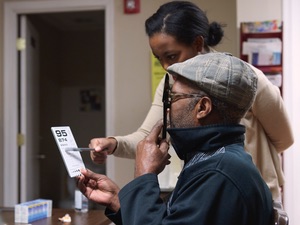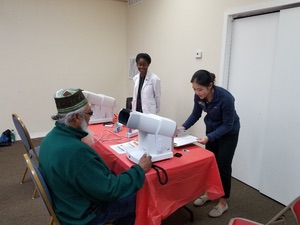The POAAGG Study
 The Primary Open-Angle African American Glaucoma Genetics (POAAGG) study seeks to understand the genetic architecture of primary open-angle glaucoma (POAG) in African Americans. Open-angle glaucoma is the most common form of glaucoma,1 a group of diseases that damages the optic nerve and causes subsequent loss of the visual field. Glaucoma is the leading cause of irreversible blindness worldwide.2 In 2014, the POAAGG study was funded by an $11.2 million grant from the National Eye Institute, which was renewed for an additional five years in 2019 for $6.6 million.
The Primary Open-Angle African American Glaucoma Genetics (POAAGG) study seeks to understand the genetic architecture of primary open-angle glaucoma (POAG) in African Americans. Open-angle glaucoma is the most common form of glaucoma,1 a group of diseases that damages the optic nerve and causes subsequent loss of the visual field. Glaucoma is the leading cause of irreversible blindness worldwide.2 In 2014, the POAAGG study was funded by an $11.2 million grant from the National Eye Institute, which was renewed for an additional five years in 2019 for $6.6 million.
Why Study African Americans?
POAG disproportionately affects African Americans compared to other populations. African Americans present at an earlier age with more severe and rapidly progressing symptoms.3 This population is 15 times more likely to become visually impaired from POAG than European Americans.4 However, despite these statistics, most genetic studies on POAG have focused on European or Asian ancestry individuals. Thus, the results of these studies have unknown relevance to African Americans.
Recognizing this unmet need, we began the POAAGG study. Thus far, the study has enrolled more than 10,250 African American patients from the Philadelphia community. Our researchers have conducted a genome-wide association study, whole-exome sequencing, and whole genome-sequencing to identify the genes involved in glaucoma in this population.
Currently, 30% of POAG patients do not respond to available therapies. In the future, the information from our POAAGG study will shed light on the African ancestry population’s increased burden of disease. It will also pave the path to more precise screening and more personalized and effective treatments. To learn about our findings thus far, you can read our publications.
POAAGG STUDY RECRUITMENT & OUTREACH
 We employed numerous methods to enroll over 10,000 participants to our POAAGG study. Considering the historical context of unethical research involving African Americans, community outreach initiatives were vital to our study's success. We established mobile clinics to address access barriers to glaucoma screenings, using a van equipped with glaucoma testing equipment to provide eye exams to local residents. We partnered with church leaders to publicize screening events, and we advertised our study at public transportation stops and on WURD radio, Pennsylvania’s only Black-owned talk radio station.
We employed numerous methods to enroll over 10,000 participants to our POAAGG study. Considering the historical context of unethical research involving African Americans, community outreach initiatives were vital to our study's success. We established mobile clinics to address access barriers to glaucoma screenings, using a van equipped with glaucoma testing equipment to provide eye exams to local residents. We partnered with church leaders to publicize screening events, and we advertised our study at public transportation stops and on WURD radio, Pennsylvania’s only Black-owned talk radio station.
We integrated community outreach strategies with hospital-based screening initiatives, inviting individuals who had previously participated in another university study or some who participated in the Penn Medicine BioBank, which preserves biological information.
Our outreach efforts provided valuable insight into implications of our research. As a result of our recruitment approaches, our study was not only impactful to the scientific community, but also created meaning for participants, who see value in its potential impact on future generations.
OPEN-ANGLE GLAUCOMA
Causes
The causes of open-angle glaucoma are not well understood. In many cases, the eye is unable to drain fluid in its normal manner. This drainage dysfunction may be caused by imbalance in the production and drainage of the fluid or blockage of the trabecular meshwork (i.e. exit from the eye). It is NOT caused by a closed drainage angle between the iris and cornea, hence the name “open-angle” glaucoma. This extra eye fluid can lead to increased pressure in the eye, causing damage to the retinal ganglion cells and the optic nerve. Other mechanisms are likely to be involved in POAG pathogenesis.
Symptoms
POAG has no symptoms in its early stages and is painless. The disease typically begins with peripheral vision loss that can go unnoticed, producing late diagnosis and intervention for this blinding disease. When left untreated, POAG can result in irreversible vision loss and blindness.
Risk Factors
The following groups are at higher risk for POAG than the general population:
- Over age 60
- Positive family history of glaucoma
- African ancestry
- High eye pressures
- Male sex
Diagnosis

Glaucoma is best diagnosed by a fellowship-trained glaucoma specialist. A full examination includes:
- Visual acuity
- Intraocular pressure
- Optic nerve examination with direct and indirect ophthalmoscopy
- Gonioscopy
- Visual field test
- Central corneal thickness and axial length measurement
- Stereo disc and fundus photography
- Optical coherence topography
Treatment

Glaucoma has several effective therapies designed to lower pressure in the eye, slowing disease progression. These therapies include:
-
Eye drops: Used to help drain fluid in the eye, and may decrease the amount of fluid made by the eye.
-
Laser trabeculoplasty: Minimally invasive laser surgery used to help drain fluid in the eye.
-
Trabeculectomy: Surgery that helps drain fluid in the eye with a small incision made in the white outer layer of the eye (sclera).
Resources
The following resources provide additional information about glaucoma, as well as support services for individuals with glaucoma.
-
Educational Resources for Glaucoma Information
-
Treatment & Support Services
-
Glaucoma Testing and Treatment Coverage
References:
- Kapetanakis VV, Chan MP, Foster PJ, Cook DG, Owen CG, Rudnicka AR. Global variations and time trends in the prevalence of primary open angle glaucoma (POAG): a systematic review and meta-analysis. Br J Ophthalmol 2016; 100(1): 86-93.
- Weinreb RN, Leung CK, Crowston JG, Medeiros FA, Friedman DS, Wiggs JL, Martin KR. Primary open-angle glaucoma. Nat Rev Dis Primers 2016; 2: 16067.
- Broman AT, Quigley HA, West SK, et al. Estimating the rate of progressive visual field damage in those with open-angle glaucoma, from cross-sectional data. Invest Ophthalmol Vis Sci 2008; 49(1): 66-76.
- Munoz B, West SK, Rubin GS, Schein OD, Quigley HA, Bressler SB, Bandeen-Roche K. Causes of blindness and visual impairment in a population of older Americans: The Salisbury Eye Evaluation Study. Arch Ophthalmol 2000; 118(6): 819-25.


